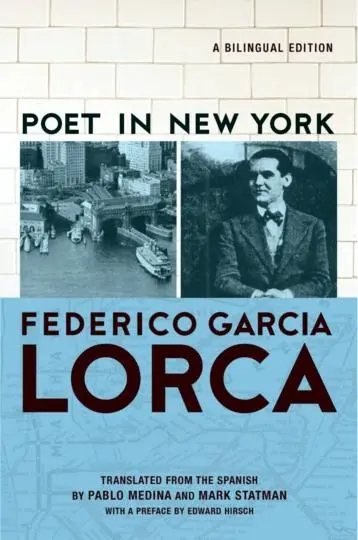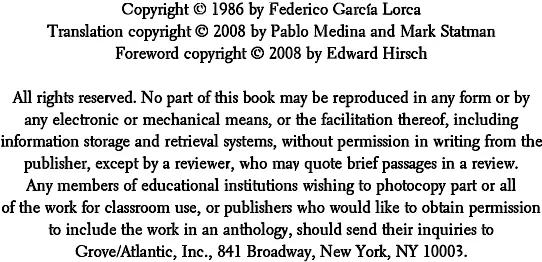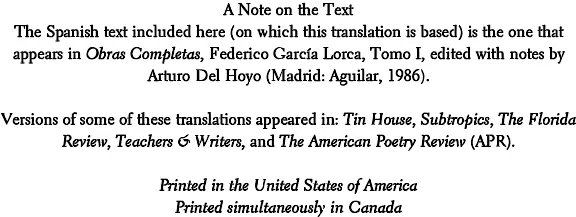Poet in New York: A Bilingual Edition

POET IN NEW YORK
POET IN NEW YORK
(Poeta en Nueva York)
Federico Garcia Lorca
Translated by
Pablo Medina and Mark Statman






Ala Nena (P.M.)
For Katherine and Jesse (M.S.)
Contents
Foreword by Edward Hirsch xi
Introduction xv
1. POEMAS DE LA SOLEDAD EN COLUMBIA UNIVERSITY 2
1. POEMS OF SOLITUDE AT COLUMBIA UNIVERSITY 3
Vuelta de paseo 4
Back from a Walk 5
1910 (Intermedio) 6
1910 (Interlude) 7
Fibula y rueda de los tres amigos 6
Fable and Round of the Three Friends 9
Tu infancia en Menton 14
Your Infancy in Menton 15
II. LOS NEGROS 18
II. THE BLACKS 19
Norma y paraiso de los negros 20
Norm and Paradise of the Blacks 21
El rev de Harlem 24
The King of Harlem 25
Iglesia abandonada (Balada de la Gran Guerra) 34
Abandoned Church (Ballad of the Great War) 35
III. CALLES Y SUENOS 38
III. STREETS AND DREAMS 39
Danza de la muerte 40
Dance of Death 41
Paisaje de la multitud que vomita (Anochecer de Coney Island) 48
Landscape of the Vomiting Crowd (Twilight at Coney Island) 49
Paisaje de la multitud que orina (Nocturno de Battery Place) 52
Landscape of the Urinating Crowd (Nocturne of Battery Place) 53
Asesinato (Dos voces de madrugada en Riverside Drive) 56
Murder (Two Voices at Dawn on Riverside Drive) 57
Navidad en el Hudson 58
Christmas on the Hudson 59
Ciudad sin sueno (Nocturno del Brooklyn Bridge) 62
City Without Sleep (Nocturne of the Brooklyn Bridge) 63
Panorama ciego de Nueva York 66
Blind Panorama of New York 67
Nacimiento de Cristo 70
Birth of Christ 71
La aurora 72
Dawn 73
IV. POEMAS DEL LAGO EDEN MILLS 74
IV. POEMS OF LAKE EDEN MILLS 75
Poema doble del lago Eden 76
Double Poem of Lake Eden 77
Cielo vivo 80
Living Sky 81
V. EN LA CABANA DEL FARMER (Campo de Newburg) 84
V. IN THE FARMER'S CABIN (Newburgh Countryside) 85
El nino Stanton 86
The Boy Stanton 87
Vaca 92
Cow 93
Nina ahogada en el pozo (Granada y Newburg) 94
Girl Drowned in the Well (Granada and Newburgh) 95
VI. INTRODUCTION ALA MUERTE
Poemas de la soledad en Vermont 98
VI. INTRODUCTION TO DEATH
Poems of Solitude in Vermont 99
Muerte 100
Death 101
Nocturno del hueco 102
Nocturne of the Hole 103
Paisaje con dos tumbas y tin perro asirio 108
Landscape with Two Tombs and an Assyrian Dog 109
Ruing 110
Ruin 111
Luna y panorama de los insectos (Poema de amor) 114
Moon and Panorama of the Insects (Love Poem) 115
VII. VUELTA A LA CIUDAD 120
VII. RETURN TO THE CITY 121
New York (Oficina y Denuncia) 122
New York (Office and Denunciation) 123
Cementerio judio 128
Jewish Cemetery 129
Pequeno poema infinito 132
Small Infinite Poem 133
Crucifixion 136
Crucifixion 137
VIII. DOS ODAS 140
VIII. TWO ODES 141
Grito hacia Roma (desde la torre del Chrysler Building) 142
Cry Toward Rome (From the Tower of the Chrysler Building) 143
Oda a Walt Whitman 148
Ode to Walt Whitman 149
IX. HUIDA DE NUEVA YORK
Dos valses hacia la civilizaci6n 158
IN. FLIGHT FROM NEW YORK
Two Waltzes Toward Civilization 159
Pequeno vals vienes 160
Small Viennese Waltz 161
Vats en las ramas 164
Waltz in the Branches 165
X. EL POETA LLEGA A LA HABANA 168
X. THE POET ARRIVES IN HAVANA 169
Son de negros en Cuba 170
Son of Blacks in Cuba 171
Acknowledgments 175
Notes on the Poems 177
Father Reading 183
Foreword
Federico Garcia Lorca spent a critical nine months in New York
(June 1929-March 1930), and created from the experience an indelible work of art, an agonized spiritual tribute to the urban
milieu, a ferocious testament. Lorca was extremely energized and
deeply appalled by the city he discovered-its "extrahuman architecture and furious rhythm," its "geometry and anguish"-and
the work he left behind still carries a sense of shock and surprise,
a weird feeling of recognition, after all this time.
Pablo Medina and Mark Statman have given us a marvelous new version of Lorca's anguished masterpiece, Poet in New
York. The destruction of the twin towers of the World Trade Center, the wake of September It, 2001, sent them back to the great
poetry of New York City, especially Lorca's fiery symphonic
cycle, which was mostly created in the midst of the Great Depression. Lorca spoke of "a poet in New York," but he recognized
that he might just as well have said "New York in a poet." So,
too, we might say that New York has lived inside these translators, two poets who have recast his work in the light of a traumatized American city. Lorca had at different times considered
calling his book The City (La Ciudad) and Introduction to Death
(Introduccion a la muerte) and, indeed, death and the city are
its twin inspiring presences, which is one of the reasons that
Medina and Statman find it so disturbingly relevant. Their translation is a major reclamation. They have given us a Poet in New
York for our time.
Lorca always recalled his stay in New York as "one of the most
useful experiences" of his life. It was his first trip abroad. He called
New York "Senegal with machines" and said that all of his native
Granada could fit into three skyscrapers. He felt "murdered by the
sky." He was stunned by the vastness and scale of the city, which
was for him a place where during the day people were mired in
mindless games, fruitless labors, and at dusk poured into the streets in a human flood.
1 comment